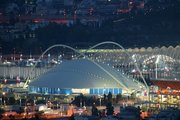Velodrome
|
|
Velodrome_racing.jpg
A velodrome is a sporting arena purpose-built for track cycling, ie: racing on bicycles.
Modern velodromes feature steeply banked tracks, consisting of two 180-degree bends connected by two straights. The corner bankings are designed so that, at typical racing speeds, the inertia of the bicycles, the propulsive acceleration provided by the riders, and the gravitation force pulling them towards the bottom of the track are balanced. The bicycles then naturally follow the track around the corner at a constant radial position. This allows the riders to concentrate on matters such as race tactics rather than steering their bicycles significantly.
The track length is measured on a special line 20 cm up from the inside start of the track. Olympic standard velodromes are 250 metres in circumference. Other velodromes can range from 150 m to 500 m, although 333.33 m is popular. Many older tracks were built around the outside of athletics tracks or other sports grounds and any banking on these was usually quite shallow. The smaller the track the steeper the banking. A 250 m track would bank in a range around 45°, while a 333 m track would bank in a range around 32°. Velodrome tracks are surfaced in wood or smooth concrete; shorter and Olympic are wood, longer are concrete.
Velodrome_track_markings.jpg
All tracks should have a standard set of markings. The inner flat space is the apron. The track begins with a 20 cm blue band (the cote d'azur), riders moving into this space in a race are disqualified. 20 cm above the cote d'azur is the black measurement line, defining the size of the track. Between 90 cm and 100 cm above the measurement line is the red spinters' line. The zone between the black and red lines is the optimum route around the track, a rider leading in this zone cannot be passed on the inside, other riders are regulated to pass on the longer outside route. 300 cm above the red line is the blue stayers' line, this is an archaism but is used in public tracks to segregate users.
The finish line is white on black and in the middle of the back straight. Marked starting lines are - the standard red start line in the opposite straight to the finish line, the massed start line, the turn 2 start line (for the 500 m time trial), and the 200 m sprint start.
While outdoor veldromes used to be the norm, new velodromes tend to be indoor venues, particuarly if they are to be used for high-level competition. A velodrome will usually be among the facilities constructed for major events such as the Olympics or Commonwealth Games.
| Contents |
List of velodromes
(outdoor, unless stated)
France
- Parc des Princes, Paris 1897 to 1967. Finish of the Tour de France.
- Velodrome du Lac, Bordeaux
Greece
- Olympic Velodrome Athens (indoor)
United Kingdom
- Aldersley, Wolverhampton
- Brighton (Preston Park), East Sussex
- Calshot, near Southampton, Hampshire (indoor)
- Cardiff (Maindy Park)
- Cleveland, Teesside
- Gypsies Green, South Shields (currently semi-derelict)
- Halesowen, near Birmingham
- Herne Hill, south London
- Kirkby, near Liverpool
- Leeds (Roundhay Park), West Yorkshire
- Leicester (Saffron Lane Sport Centre) (soon to be sold and demolished - 2004)
- Meadowbank, Edinburgh
- The National Cycling Centre, Manchester (indoor)
- Newcastle-under-Lyme, Staffordshire
- Newport, Monmouthshire (indoor)
- Portsmouth Southsea, Hampshire
- Reading (Palmer Park) Berkshire
- Welwyn, Hertfordshire
Canada
- Burnaby Velodrome, Burnaby, British Columbia (indoor)
- Juan de Fuca, Colwood, British Columbia
- Forest City Velodrome, London, Ontario (indoor)
United States of America
There are about 20 tracks in the United States, including:
- ADT Event Center in Carson, California (indoor track)
- Alkek Velodrome in Houston, Texas
- Alpenrose Velodrome in Portland, Oregon
- Baton Rouge Velodrome in Baton Rouge
- Dick Lane Velodrome in East Point, Georgia
- Ed Rudolph Velodrome in Northbrook, Illinois
- Encino Velodrome in Encino, California
- Group Health Velodrome in Marymoor Park, Redmond, Washington
- Hellyer Park Velodrome in San Jose, California
- Kissena Park Velodrome in Queens, New York
- Lehigh Valley Velodrome in Trexlertown, Pennsylvania
- Major Taylor Velodrome in Indianapolis, Indiana
- Mike Walden Velodrome in Rochester Hills, Michigan
- San Diego Velodrome in San Diego, California
- 7-Eleven Velodrome in Colorado Springs, Colorado
- EDS Velodrome in Frisco, Texas
The Netherlands
External links
- www.bikecult.com list of velodromes (http://www.bikecult.com/bikecultbook/sports_velodromes.html)
- ADT Event Center (http://www.homedepotcenter.com/venues/customadtevent.sps?iType=4176&icustompageid=6773)
- Alkek Velodrome - Houston, Texas (http://www.houstontx.gov/alkekvelodrome/)
- Burnaby Velodrome (http://www.burnabyvelodrome.ca)
- Dick Lane Velodrome (http://www.dicklanevelodrome.com)
- Encino Velodrome (http://www.encinovelodrome.org/)
- Forest City Velodrome (http://www.forestcityvelodrome.ca)
- Hellyer Park Velodrome (http://www.ridethetrack.com)
- Herne Hill Velodrome (http://www.hernehillvelodrome.co.uk)
- Kissena Park Velodrome (http://www.kissena.info)
- Lehigh Valley Velodrome (http://www.lvvelo.org/)
- Major Taylor Velodrome (http://www.indygov.org/eGov/City/DPR/Parks/Major+Taylor+Velodrome.htm)
- Marymoor Velodrome Association (http://marymoor.velodrome.org/)
- Manchester Velodrome (http://www.manchestervelodrome.com)
- Mike Walden Velodrome (http://www.velodromeatbloomerpark.com)
- San Diego Velodrome (http://www.sdvelodrome.com/)
- Portland, Oregon Velodrome (http://www.obra.org/track/index.html)
- Northbrook, Illinois Velodrome (http://www.northbrookvelodrome.org/)
- Velodrome Amsterdam (http://www.velodrome.nl/)
- Sportpaleis Alkmaar (http://www.sportpaleis-alkmaar.nl/)
- Victoria, BC Velodrome (http://www.gvva.bc.ca/)

